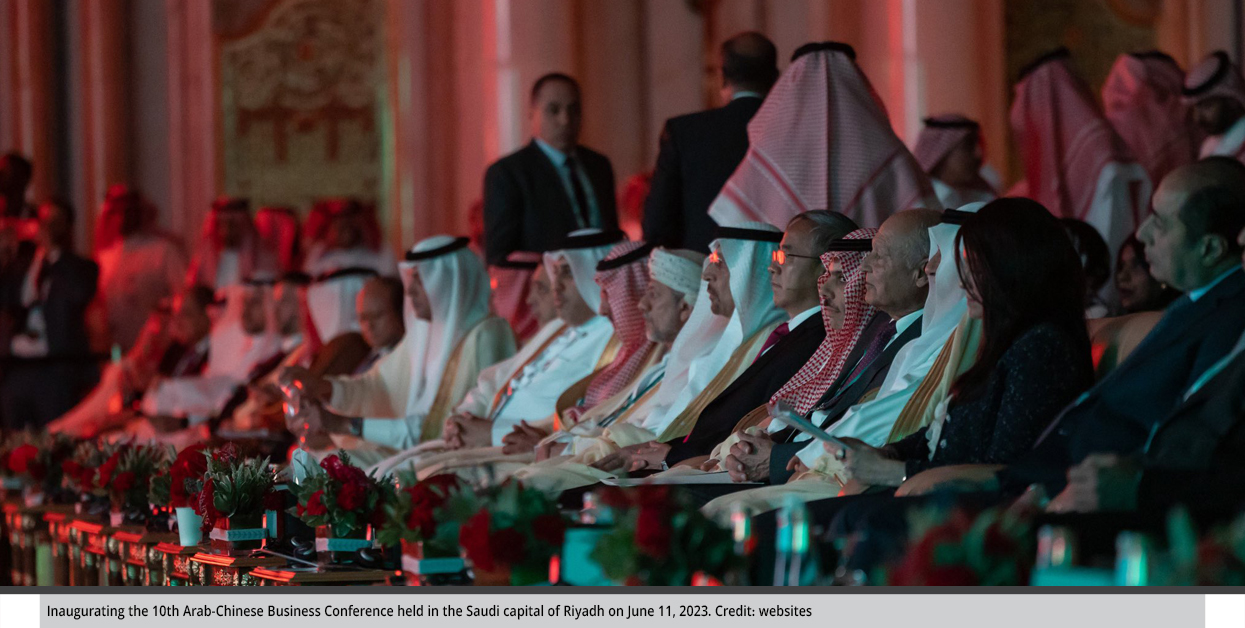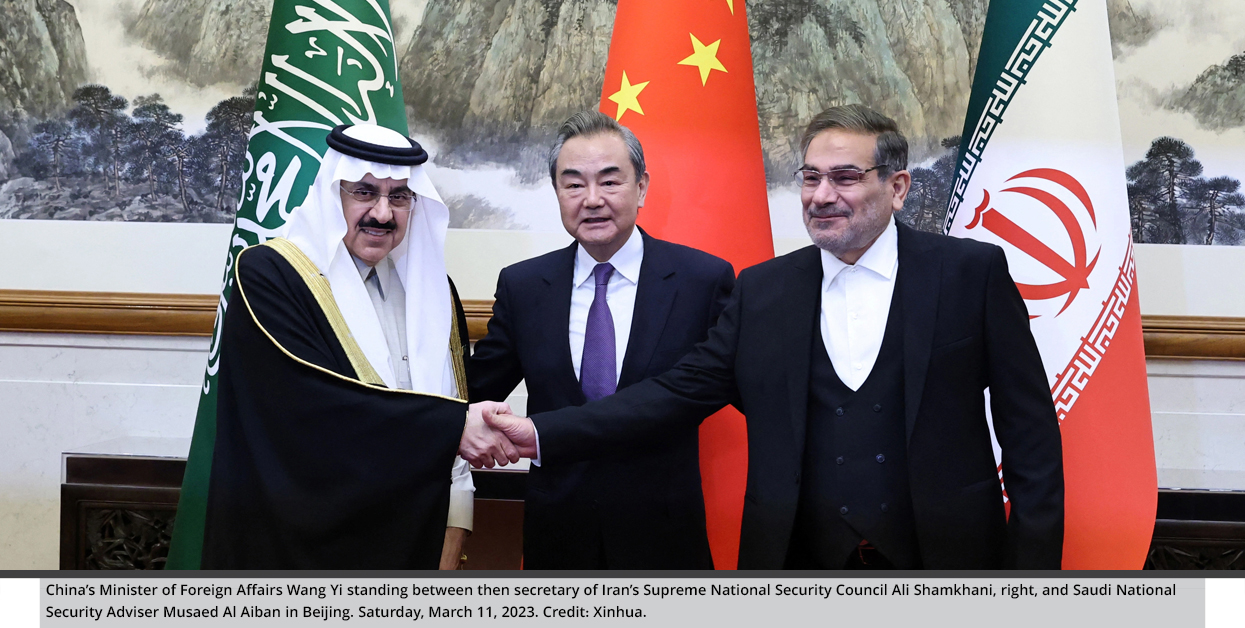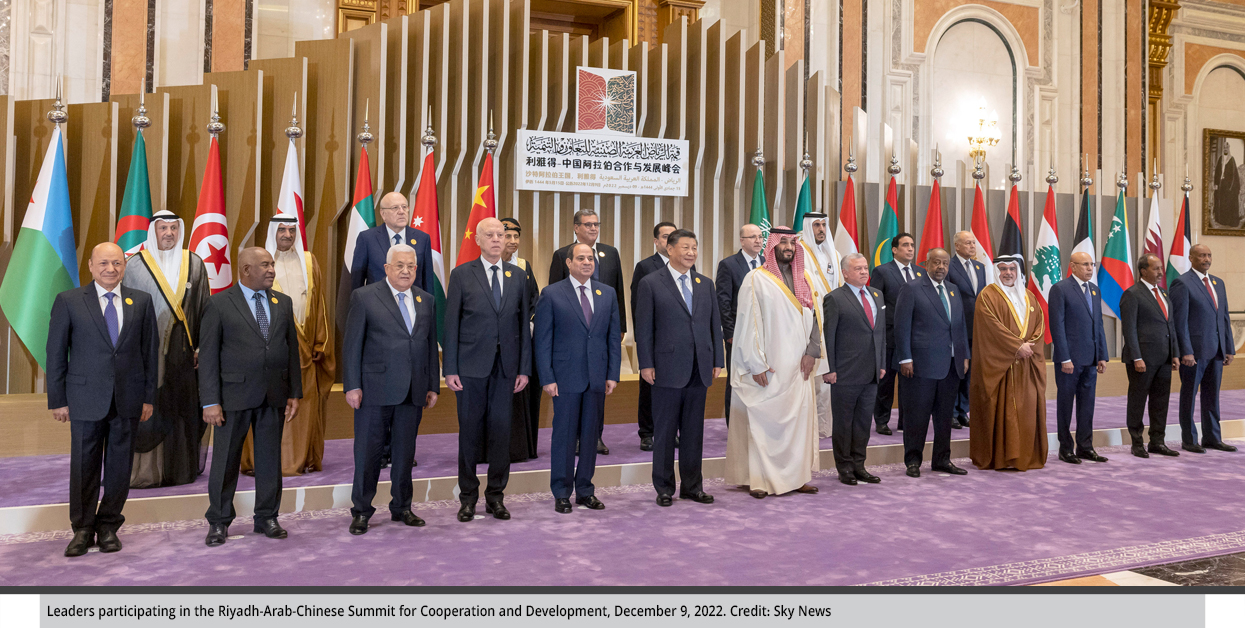Saudi-China Relations From the Perspective of Political Economy and Energy Geopolitics
This analysis deals with Saudi-China relations from the perspective of political economy and geopolitics of energy. It touches on the rapid growth between the two countries in various fields, the latest of which was Riyadh hosting the 10th Arab-Chinese Business Conference nearly six months after China’s president held three summits with leaders from Saudi Arabia and the Gulf and Arab countries.
by STRATEGIECS Team
- Release Date – Jul 16, 2023

The 10th Arab-Chinese Business Conference, held in the Saudi capital of Riyadh from June 11 to 12, 2023, was a further step in the advancement of Saudi-China relations since the visit of Chinese President Xi Jinping to Saudi Arabia in December 2022 that included three summits with the leaders of Saudi Arabia, the Gulf Cooperation Council, and Arab countries. The Chinese Ministry of Foreign Affairs described this year’s visit as “the largest diplomatic activity between China and the Arab world since the founding of the People’s Republic of China.”
The conference witnessed the participation of more than 4,500 entrepreneurs, experts, and investors from public and private sectors in 26 countries. In addition, the conference included many meetings and events aimed at deepening economic cooperation between the Arab world and China. The conference resulted in the signing of agreements worth more than $10 billion. What was most remarkable, however, was the announcement by Saudi Minister of Investment Khalid Al-Falih about launching a new modern Silk Road between China and the Arab world.
The conference itself was a continuation of the Comprehensive Strategic Partnership Agreement between Riyadh and Beijing as well as the plan to align Saudi Arabia’s Vision 2030 with China’s Belt and Road Initiative.

Implications of Saudi-China relations and the dimensions
Interpreting the implications of Saudi-China relations and the dimensions of their future development is based on a political economy approach as an analytical tool concerned with studying power relations and political conflicts within the network of their interactions and economic basis. This approach considers politics as an intensive expression of the economy and it considers the political economy of energy as a procedural entry for that analysis. In the case of Saudi-China relations, studying the most important elements of that approach is best represented by Vision 2030 and the Belt and Road Initiative, and the alignment between them.
The plan to align the Saudi “vision” with the Chinese “initiative” came as a natural result of the common factors between the two countries in their economic projects and strategic interests, and what their common factors may achieve for them. Saudi Arabia has an ambitious vision that requires a massive amount of infrastructure construction, along with the development of unconventional energy industries, artificial intelligence, and biotechnology that China can provide with high efficiency and under competitive conditions. On the other hand, China needs Saudi energy sources and raw materials. It also needs Saudi Arabia and other Gulf and Arab countries as markets for its products and investments.
In fact, Vision 2030 reflects a transformation in Saudi Arabia’s domestic and foreign policies, as well as its Arab, regional, and international role. Saudi Arabia established a new foreign policy based on multiple partnerships, diversification of options, and adoption of peaceful tools in the face of crises. This was evident in the announcement of resuming the Saudi-Iran relations with a Chinese guarantee on March 10, 2023. It was also reflected in Saudi efforts to reach a comprehensive agreement leading to a permanent ceasefire in Yemen; the Saudi role in evacuating Arab and foreign nationals and diplomatic missions from Sudan; and its continuous efforts to reach a peaceful solution that ends the Sudanese crisis, a role reflected in the three Jeddah initiatives that involved American participation.

Thus, Saudi Arabia is seeking to enhance regional stability by raising the levels of its political and diplomatic roles, which are closely linked to its economic ambitions that require a stable regional environment in which countries have the tools and means to peacefully resolve disputes and conflicts.
Meanwhile, the Belt and Road Initiative, which depends on the growing role of China, especially at the economic level, is reflected in the words of President Xi at the 2013 Beijing summit when he called for building an “open world economy” based on free development and building systems that follow “fair, rational, and transparent trade and investment laws.”
Thus, the growing ties in Saudi-Chinese relations can be interpreted from political economy and energy geopolitics approaches. The most prominent five are listed below.
First, Saudi Arabia is one of the world’s largest producers of petroleum, while China is the world’s largest energy consumer. This established a comprehensive strategic partnership, as Saudi Arabia is the largest supplier of petroleum to China and the source of 18% of China’s total purchases of crude oil. Chinese petroleum imports from Saudi Arabia during the first ten months of 2022 amounted to about $55.5 billion. The two countries have also jointly invested in the petrochemical sector: Saudi Aramco is building a refinery and petrochemical complex in the northeast China expected to begin operations in 2024, and Saudi Arabia acquired a 10% stake in Rongsheng Petro Chemical Ltd., which is listed on the Shenzhen Stock Exchange.
Second, in addition to energy and petroleum, joint cooperation between Beijing and Riyadh includes bilateral trade and joint investments. For example, as the value of Arab-Chinese trade reached $430 billion in 2022, about $106 billion of it was with Saudi Arabia. In comparison, Chinese investments in the Arab world in 2021 amounted to $23 billion, including $3.5 billion in Saudi Arabia.
Third, the two countries seek to strengthen their military and defense relations. The final statement of the Riyadh-Arab-Chinese Summit for Cooperation and Development in December 2022 showed “the development of cooperation and coordination in the defense fields,” especially in combating organized crime and terrorism, and the exchange of experiences in the fields of “early intelligence warning and security risk assessment.” The two countries entered into defense agreements, including a partnership between Saudi Arabia’s Advanced Communications and Electronics Systems Company and China Electronics Technology Group to manufacture drone payload systems in Saudi Arabia.

Fourth, reflecting the development in relations between the two countries, on March 29, 2023, Saudi Arabia became a “dialogue partner” in the Shanghai Cooperation Organization, a Chinese-led intergovernmental organization headquartered in Beijing. Multiple reports indicate that there are high prospects for Saudi Arabia joining the BRICS economic bloc comprised of Brazil, Russia, India, and South Africa during the BRICS summit in South Africa scheduled for August 22–24.
Fifth, the aforementioned announcement by Saudi Investment Minister Khalid Al-Falih regarding the launch of a modern Silk Road between China and the Arab world is both an advanced step in Saudi-China relations and a practical application of alignment between Vision 2030 and the Belt and Road Initiative. This announcement carried many important determinants, foremost of which is Saudi Arabia’s pivotal position as a bridge linking China with Arab countries on the one hand and with Africa and Europe on the other.
Sixth, the 10th session of the Arab-Chinese Business Conference included launching the “Riyadh Declaration” that aims to “strengthen economic partnerships, explore new opportunities for cooperation, support entrepreneurship and small and medium enterprises, exchange scientific research and innovations, organize qualification and training programs to enhance human capital, activate cooperation to achieve market stability, address social and economic challenges, promote economic integration, and maximize renewable energy sources.” In addition to their quality and importance, the deals resulting from the conference, as stated earlier, exceeded $10 billion. Among them were:
- Amar First Company and Zhonghuan International Group Co., Ltd. signed a deal worth $533 million to establish an iron ore processing plant and manufacture iron pellets for smelting plants.
- The Saudi Ministry of Investment signed an agreement with the Chinese company Human Horizons, specialized in developing self-driving technologies and in manufacturing electric cars, a deal worth $5.6 billion, to establish a joint venture to manufacture and sell electric vehicles.
- ASK Group and China National Mining and Geology Corporation signed a $500 million agreement to develop, finance, construct, and operate a copper mining project in the Arabian Shield region.
- Mabani Al Safwa Co. Ltd., China Gezhoba Group International Engineering Co. Ltd., and Top International Engineering Limited signed a framework agreement worth $266 million for constructing advanced buildings in Saudi Arabia.
- The Saudi Ministry of Investment and Hipopi Technology Company signed an agreement worth $266 million to develop applications in the field of tourism.
Finally, regarding the foregoing, four key milestones can be drawn in the course of Saudi-China relations.
First, the relationship between Saudi Arabia and China is based on firm rules of political economy principles in general and the political economy of energy in particular. In the latter, economic power constitutes a basic structure for the political role of a state, and it is a central factor in drawing up the state’s policies and determining the state’s influence and network of relations in an atmosphere of mutual influence between the elements of economic power and the political role—or between the market and foreign policy, where political goals are not separated from economic goals—so that the political role is augmented by increasing economic power, while the economic power is enhanced by increasing political influence.
Second, in the strategic interests of the two countries, Saudi Arabia and China are moving on a pragmatic and progressive path characterized by depth and quiet development in light of major political and economic transformations witnessed by the international community. It is expected that the course of these relations will rapidly develop in the coming months and years, especially after Saudi Arabia agreed to join the Shanghai Cooperation Organization as a “dialogue partner,” and in the event that Saudi Arabia joins the BRICS economic bloc, thereby taking a pivotal geopolitical position in China’s Belt and Road project.
Third, although the development of Saudi-China relations is seen as based on the convergence of their positions towards the United States, Saudi Arabia recently showed that its positions are commensurate with the nature of its own interests. For instance, Saudi Arabia’s close to neutral position towards the Ukrainian crisis and its support for reducing oil production in OPEC+ despite American objections. However, this does not mean neglecting the Saudi-U.S. relations strategy as much as it means that these relations have entered a new and more balanced phase for Saudi Arabia. Meanwhile, China is seeking to overcome the competitive nature and Western economic pressures towards its vital interests.
Fourth, China’s attempts to develop and strengthen relations with Saudi Arabia, the Gulf countries, and the Middle East is a strategic direction governed by the missing cooperation with the West, as the cooperation between China and the West is governed by the West’s competitive nature towards China, in light of the exacerbation of global economic crises and the problems of energy security and food security, which pose a common challenge to Saudi Arabia and China. This requires establishing a safe incubator environment for huge Chinese investments in the region. And it also requires new political arrangements based on calming hotbeds of tension and resolving disputes by peaceful means, which, for example, began to be achieved with the resumption of Saudi-Iran relations with a Chinese guarantee.

STRATEGIECS Team
Policy Analysis Team
 العربية
العربية